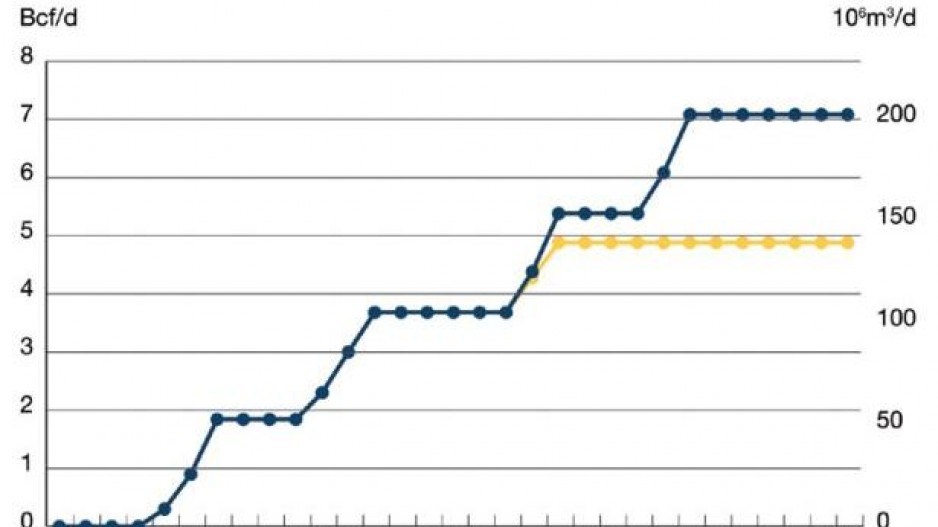Fossil fuel consumption in Canada peaked in 2019 and will decline by 12% by 2030, provided the federal government can stick to its ambitious carbon reduction plans.
That’s the prediction being made by the Canadian Energy Regulator (CER) in it is first IEA-style energy outlook.
Every year, the International Energy Agency (IEA) produces a global energy outlook. The CER is now using a similar scenarios-based model to predict what Canada’s energy consumption and production profile could look like over the next three decades.
It focuses on both domestic energy use, and energy exports in three key areas: oil, natural gas and electricity.
It uses two scenarios. The reference scenario is one in which nothing much changes with respect to decarbonisation and climate change action beyond what is already in place. The evolving scenario assumes a global effort to step up climate action and decarbonisation.
Under the evolving scenario, the outlook concludes that Canada’s consumption of fossil fuels already peaked in 2019, and will decline by 12% by 2030 and 35% by 2050.
Under the evolving scenario, the CER assumes Canada’s carbon tax will rise to $75 per tonne by 2040, and $175 per tonne by 2050.
Even under an evolving scenario, which assumes increased climate action and decarbonisation policies, the CER energy outlook forecasts Alberta’s oil production will continue to grow by about 1 million barrels per day by 2040, then begin to decline, while natural gas production increases by 2.7 billion cubic feet per day (Bcf/d), driven largely by exports of liquefied natural gas (LNG).
Meanwhile, electricity production shifts towards cleaner sources, and coal power is phased out entirely. The outlook forecasts hydro power, wind, solar, and biofuels used to generate electricity will increase by 45% between now and 2050, and nuclear power to grow by 2%.
While it predicts Canada’s own fossil fuel use will steadily decline, it assumes Canadian oil production and natural gas production will continue to grow, since much of the Canada produces is exported, although the outlook suggests that there may be more pipeline capacity than required for its oil production, should all three new pipeline projects (Trans Mountain, Keystone XL and Line 3) get built.
The outlook predicts that, under the evolving scenario, Canada’s oil production output will increase over next two decades by close to 1 million barrels per day (MMb/d): from 4.9 MMb/d in 2019 to 5.8 MMb/d in 2039, mostly in Alberta.
“Much of the growth in oil sands production is in the form of expansions to existing facilities,” the outlook states.
Under the reference scenario, oil production would grow by 2.3 MMb/d to 7.2 MMb/d.
But if all three oil pipelines that are either already being built or proposed are finished, Canada might end up with a surplus of pipeline capacity.
Alberta’s problem has long been a lack of pipeline capacity, which has resulted in Alberta oil selling at a discount. Three new pipelines or expansions are already underway or proposed to be built soon: the Trans Mountain expansion, Line 3 and the Keystone XL. Those expansions would increase pipeline capacity by a total of 1.7 million barrels per day.
In recent years, Alberta producers have moved thousands of barrels of oil to the U.S. by rail, which is more expensive, so some of that new spare pipeline capacity would likely be filled with current oil production.
But if the CER outlook is right and Alberta’s production grows by only 1 million barrels by 2040, the expanded pipelines might end up with surplus capacity.
“With these announced pipeline projects assumed to proceed as proposed, crude available for export from western Canada remains below total pipeline capacity over the next 30 years in both scenarios,” the outlook states.
Both Line 3 and Keystone XL would increase pipeline capacity, but it wouldn’t change the fact that Alberta producers would still be captive to a single customer – refiners in the U.S. Midwest and Gulf Coast.
The Trans Mountain pipeline expansion is the only one that would give Alberta producers access to other markets – notably California and Asia, including China and India.
Natural Gas and LNG exports to grow
As for Canadian natural gas, the CER expects it to increase in production over the next two decades, from the current 15.7 billion cubic feet per day (BCf/d) to 18.4 Bcf/d by 2040.
That growth will occur despite declining domestic use of natural gas, as much of the anticipated growth is driven by exports in the form of liquefied natural gas (LNG).
Under the evolving scenario, LNG production and exports are projected to be 2 Bcf/d in 2025. That basically represents a single large LNG project now under construction: LNG Canada. It projects LNG exports to double to 4 Bcf/d in 2030-2035, and peak at 5 Bcf/d in 2040. Under a reference scenario, LNG exports would peak at 7 Bcf/d.
Both crude oil and natural gas production is expected to begin declining after 2040.
Electricity
The outlook forecasts non-emitting electricity to increase its share of Canada’s energy mix in the coming decades. Currently, electricity accounts for 16% of the total energy mix. It is expected to increase to 27% by 2050, at which time half of all passenger vehicles sales will be electric.
The outlook forecasts hydroelectricity, wind, solar, and biofuels to generate power will increases by 45% from 2019 to 2050 in the Evolving Scenario. Nuclear demand increases by 2%. Coal power is phased out altogether.
“Combined with declining fossil fuel use, the share of these low and non-emitting sources increases from 23% of the energy mix in 2019, to 38% by 2050,” the outlook predicts.




